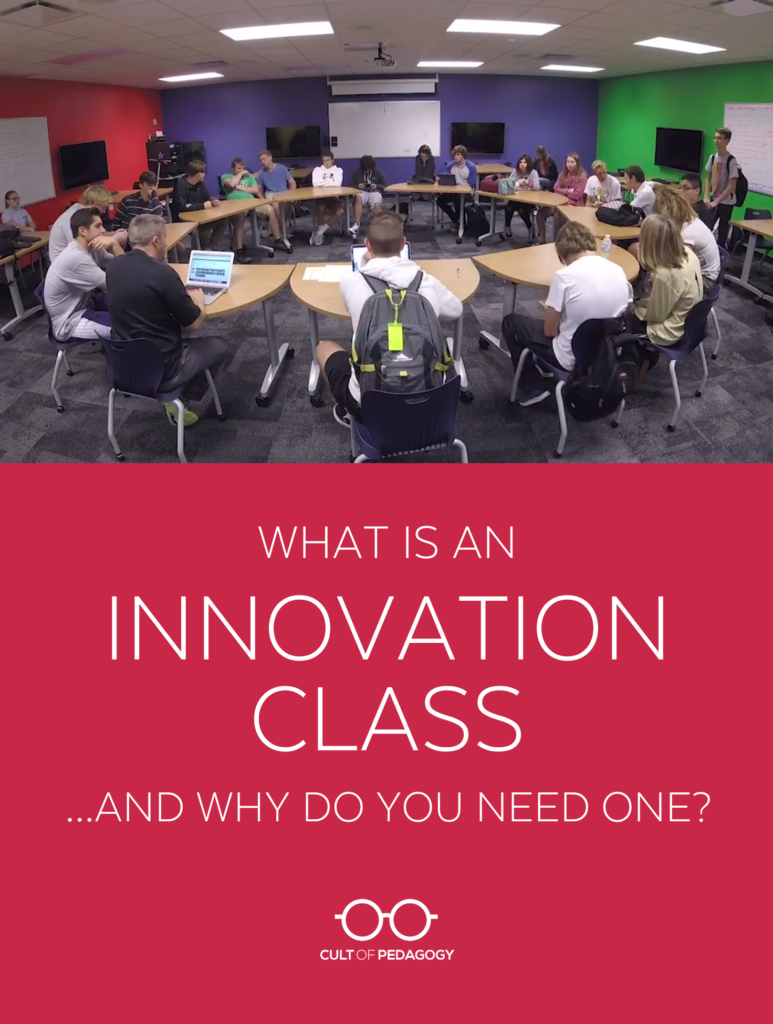
Listen to my interview with Don Wettrick (transcript):
Sponsored by simpleshow videomaker and Peergrade
This post contains Amazon affiliate links. When you make a purchase through these links, Cult of Pedagogy receives a small portion of the sale at no extra cost to you.
I hear it all the time: The world is changing, and schools need to change. Lots of us recognize that we should no longer be relying on the old model, where we just dump information into our students’ brains and they regurgitate it back. The world we live in today requires more of people: problem-solving skills, creativity, collaboration, the ability to innovate, iterate, and design solutions for problems that don’t even exist yet. The way we do school now just doesn’t prepare kids the way it should.
It’s a good message, a true message, but too often, that message leaves us hanging. We nod along, we agree that things need to be different, but then we go back to doing more or less what we’ve always done, because we aren’t exactly sure HOW to change school.
Luckily, more people are starting to figure it out, and part of my mission here is to share their ideas with you. In the past, I have interviewed the teachers at the Apollo School, an innovative program blending history, English, and art that’s run inside a public high school in Pennsylvania. I’ve talked to Steven Ritz, whose incredible urban gardening projects transformed his Bronx classroom and the lives of his students. And I also told the story of an underused middle school library in Ohio that completely reconfigured its space into a collaborative, flexible, technology-rich learning hub that now stays busy all the time.
Now let’s look at another model for 21st century learning, a year-long elective offered in an Indiana high school where students design and execute their own passion-driven projects. The course is called Innovation and Open Source Learning, and the teacher’s name is Don Wettrick. In our podcast interview, Don tells me about how the course works, how he structures it to build in both accountability and freedom for his students, and how he’s changed and improved the program over the past six years. The key points from our conversation are summarized below.
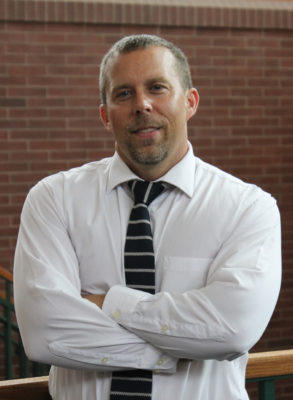
Don Wettrick
My hope is that when you learn about this innovation class, you’ll start to think about how you might implement something similar in your own school; if not a fully fledged class, then maybe an after-school club or a pull-out program, a way to differentiate for some students. To learn even more about Don’s course and how it works, head over to Don’s website, startedupinnovation.com, where you’ll find links to his podcast, his Facebook page, and his YouTube channel, where he shares daily video logs that document his students’ work in class.
What is this class?
The official name for the course is “Innovation and Open Source Learning.” Wettrick started teaching it six years ago as an extension of the Genius Hour idea, where students work on projects of their own design, focusing on topics that interest them.
Although Wettrick found that Genius Hour worked fine in an elementary setting, it wasn’t as easy to implement in high school, where time is chunked into different content areas and teachers have fewer hours to spare. So six years ago, he introduced the course as a year-long elective.
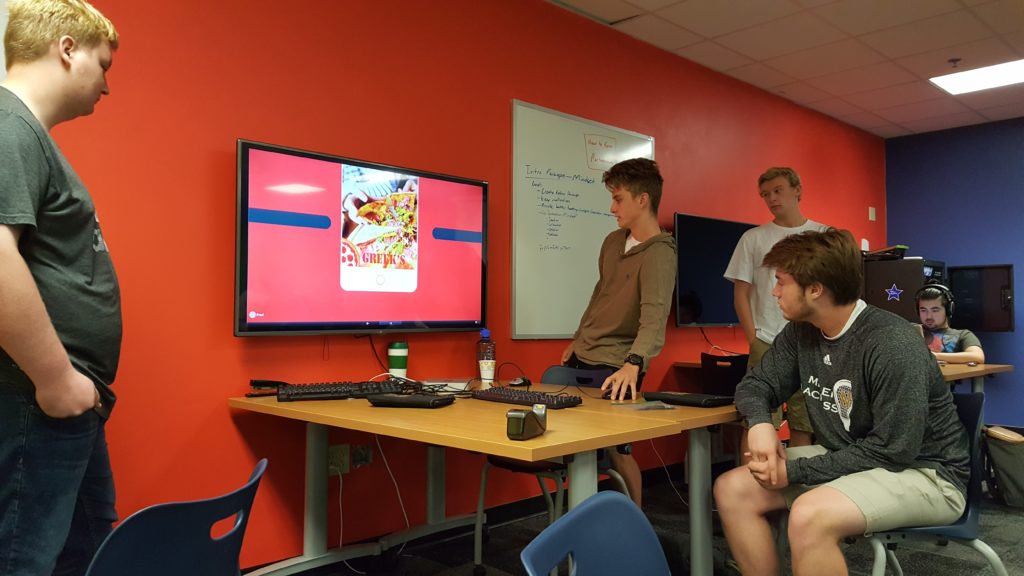
Students in Wettrick’s class work individually on projects, or they may choose to set some goals as a group.
How does it actually work?
Part 1: Innovation
The first seven or eight weeks of the course make up the “Innovation” phase: This looks more like a traditional class, where Wettrick does a lot of direct instruction to prepare students for the rest of the year.
During this phase, students are introduced to the concept of innovation and taught to think differently about what school could be like. Wettrick opens their minds to new ways of thinking by exposing them to a collection of ideas and activities.
“We have a couple of TED talks that we watch,” he explains. “We’ll play a couple of games—Disruptus is such an easy, fun game that gets a lot of things going. I’ll give them short excerpts from books like Seth Godin’s Linchpin. I have them listen to podcasts. I’ll show them clips from Tony Wagner’s film Most Likely to Succeed. And I’ll show them all the urgency, all this media on ‘Schools should change, schools should change, schools should change.'” This helps students understand the point of the course and how it will require them to approach learning in a different way.
While reframing students’ thinking, Wettrick also equips them with the tools and skills they’ll need for the second phase, where they will actually design and implement their own projects:
- Students learn how to set SMART goals.
- They study the protocols they will use for planning, implementing, and reflecting on their projects.
- They set up public-facing social media profiles “where people want to follow you, that they’re shocked and amazed that somebody at 16 years old is going to be tackling great problems,” Wettrick says.
- Each student starts a blog, a podcast, or a YouTube channel, which they’ll use to submit the required course reflections.
Part 2: Open Source Learning
For the rest of the year, students get to work on their self-directed projects. Some work on a different project every two weeks, while others work on incremental stages of a long-term project.
Wettrick uses the acronym ROTH-IRA to describe their innovation cycle. In this case, it has nothing to do with finances, but the process of thinking of an idea and taking it all the way through and beyond its implementation.
R = Realization
In this step, students are noticing things and thinking about problems that need addressing. “Just go observe things,” Wettrick tells them. “And so they’ll get this realization. Like, ‘Oh my gosh,’ and then when they do, I’m asking them to jot it down.”
O = Open Discussion
During this phase, students talk through their ideas with the rest of the group, which Wettrick says can lead to challenges. “What you thought may have been a good idea, you say out loud, and then the rest of the group, it’s their turn to fight.” This leads to the next step.
T = The Tussle
This is part of the open discussion, where students refine their ideas by talking through them—which can often be kind of a “tussle”—with others.
H = Homogeneous Grouping
As students shape their goals, they begin to come together with other students who might want to work toward the same goals but have different skill sets that can complement one another.
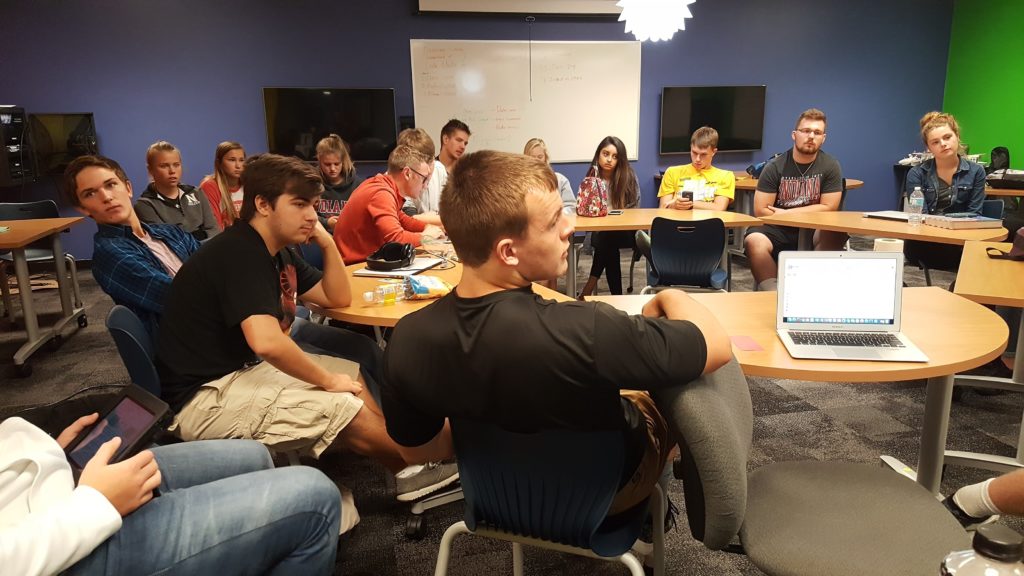
Open discussion is an important part of the innovation process. During these sessions, students challenge each other’s ideas, which ultimately helps to refine them.
Once the idea is in place, the implementation begins.
I = Ideation
This is where students make a plan of action: “What’s keystroke one?” Wettrick says. “What is prototype No. 1? What is phone call one? What is connection one?”
R = Reflection
After meeting the first two-week goal, students reflect on their progress, take an honest look at what went wrong, and celebrate successes.
A = Adjustment
Finally, students set new goals based on the progress they’ve made so far and the lessons they have learned.
This video explores the ROTH-IRA framework in more detail.
How do Students Figure Out What to Do?
All of this sounds really good if students already know what they want to do for their projects. But students who have spent years in a system that tells them exactly what to do need some time to adjust to all this freedom.
Wettrick teaches students how to listen to the conversations they hear in their daily lives. “When you hear people say, ‘You know what sucks?’ Their ears are going, ‘What?’ There’s money to be made. There (are) problems to be solved. And so they become active searchers of problem solving.”
Once students become more attuned to listening for problems, their next step is to choose the problems that fit their interests. “Pick your lane,” Wettrick tells them. “If you’re really into social justice, look around. What can you do to fix it? Don’t go to a protest and that’s it. What are you going to do? If your thing is animal cruelty, what are you going to do? If your thing is making money, what are you going to do?”
Before they can start setting goals for a project, students have to get the project approved. Projects have to satisfy what Wettrick calls the rule of thirds: “Rule number 1: Are you passionate about it? That one’s easy,” he says. “Number 2, what’s your skills acquisition on this? And number 3, who is it benefiting other than you? Because I don’t care if you’re successful. I want you to be empowering others.”
Here’s an example: One student wanted to focus on day trading. He had a definite passion for it. “He’s like, ‘Bro, I’m making money. I want to make money,'” Wettrick says. Although his skills weren’t great, he was committed to learning. When it came to rule 3, however, the plan wasn’t up to par, so Wettrick didn’t approve it. So the student decided to start a stock club, where he would teach other students what he was learning and do day trading with simulated money. Then his project was approved.
Some students get rule 3 on the first try, like these two who are building a school in Africa:
- The podcast and YouTube channel students created to help other students deal with depression,
- The student who is producing a video channel to showcase his school’s cross country matches
- The brothers whose YouTube channel helps other guys develop an affordable fashion style
How do you hold students accountable?
As part of their project proposals, students set goals for themselves. Every two weeks students submit reflections on their goals in the form of a blog post, podcast, or video. They also conference with Wettrick about the progress they’re making on their goals. Ultimately, their grades are based on the quality of their reflections and on how well they met the goals they set for themselves. This video explains the process:
Learn More
All of this is just a small sample of what Wettrick and his students share online about their process. If you’re interested in starting an innovation class in your school, visit Wettrick’s website, StartEDUp. Also, check out his courses on Innovation in the classroom.
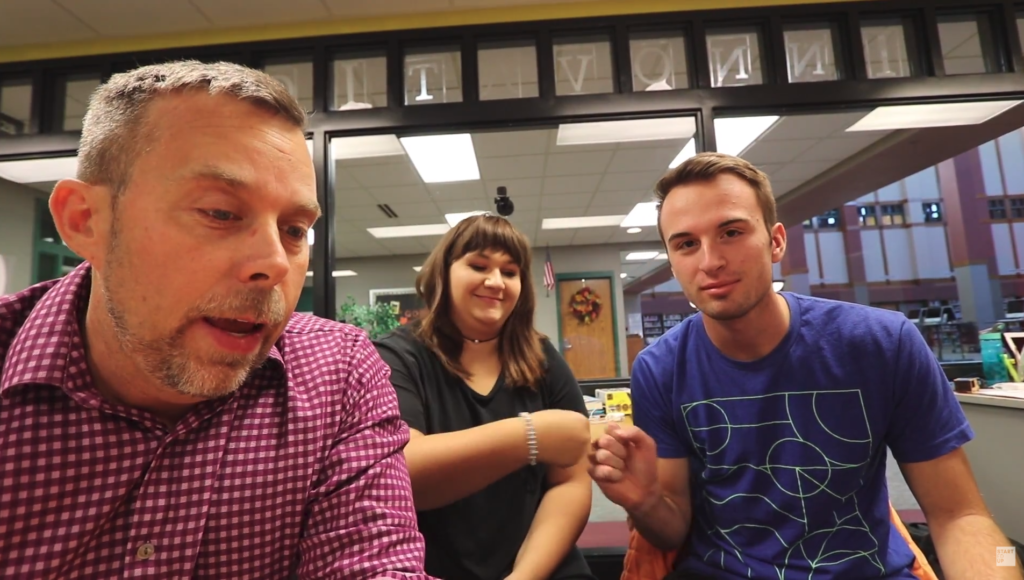
On the StartED Up YouTube channel, Wettrick and his students post daily vlogs about their work.
Even if you’re not quite ready to go as far as pushing for a full course like this one, my hope is that this model will provide one more template we can all use to rethink the way we’re doing things now, one more approach to making school a place that gives our students a chance to practice solving problems for the rest of their lives. ♦
Join my mailing list and get weekly tips, tools, and inspiration—in quick, bite-sized packages—all geared toward making your teaching more effective and fun. You’ll get access to my members-only library of free downloads, including 20 Ways to Cut Your Grading Time in Half the e-booklet that has helped thousands of teachers save time on grading. Come on in!!

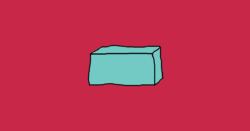
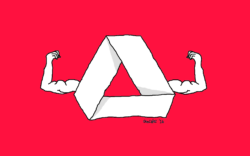
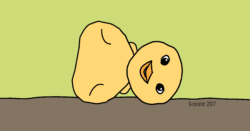
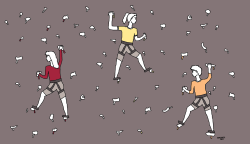
Does this borrow ideas from the Montessori learning model? The personalized, student driven learning sounds similar.
Yes, I believe that soooooo much can be taken from the Montessori model!
Kazzan Road – Tameen Ahlya Compound Build (2) Flat (301)
May I translated the article into Arabic and published for the benefit of Arabic speakers and fluent in English with the commitment of all the details
Hi! This is Holly, a Customer Experience Manager. It’s wonderful to hear that this Cult of Pedagogy resource will be reaching an Arabic-speaking audience! Yes, you have permission to reprint the article in Arabic, as long as proper attribution is given to Jenn, the author of the original post, and you provide a link so people can read the original in English. Thanks so much for checking with us on it!
I am so interested in this article. May you share please the article in Arabic if you translated it. Thank you.
It can be done at middle school level too! I began coming up with my own ideas for a class. I had ideas of maker education, genius hour and PBL swirling. I turned to reading and eventually came across Don Wettrick’s book. I was blown away at many of the similarities between my ideas and what he was already doing. I reached out and Don was a huge help! I had a google hangout session with him as well as one with him and his students to my students last year. I am now in year 1 of full implementation of my similar version. Thanks Don
Just saw a post on LM_NET, the international librarian’s listserv, about a new innovation website. It looks to be helpful, so I share the site URL and part of the original post here.
https://theinnovationdestination.net/
“For those of you who are involved in innovation activities in your schools, The Innovation Destination website was launched to a receptive audience of school librarians and teachers at the American Association of School Librarian’s national conference in Phoenix. This site is funded, in part, by a National Leadership Grant from the U.S. Institute of Museum & Library Services (IMLS). The purpose of this totally free website is to provide a one-stop site containing a wealth of information related to youth and innovation. For adults, it provides resources for encouraging, motivating, supporting, guiding and informing their young innovators, as well as a number of resources and training just for adults. It is also a site where the young innovators, themselves, can go on their own to watch the videos, find good books to read (fiction and nonfiction), and more.”
Ruth V. Small, Ph.D., Project Director, Young Innovators Project
School of Information Studies, Syracuse University
This podcast continues to draw me in with awesome ideas. Thank you, Jennifer.
What Don W is doing with students is wonderful. Surveys show that employers want more problem solving, team skills, communication skills. Oddly, they don’t mention innovation. All the skills they want are taught here. The skills of innovation will serve them and society well.
Kudos to Don W for his rule of thirds. It’s an excellent, simple, but profound way of organizing the personalization that happens in the course.
I wrote a post on the transferable competencies need in a new college general education, but was short on examples of it being done. Don’s work is an example that captures many of the points. Please see the framework, synthesized from common employability skills and the LEAP framework for general education: https://head4knowledge.com/2017/11/04/transferable-competency-framework/
I am the coordinator for the Academy for Careers in Education at Desert Hot Springs High School near Palm Springs, California. My 11th grade Ed Psych students are working on a project to design the classroom of the future and this is exactly the sort of research I want them to pursue. So grateful to have stumbled across this article! Education is morphing at a rate that far outpaces the changes we are making to accommodate growth. This is the way we need to evolve.
Very interesting perceptions of education. Am a teacher and interested
Hi Don,
So glad to see this happening in more high schools. Years ago I think I was one of the only ones using genius hour in my secondary classes. After 2 years, students prompted me further to develop it as a course. I was fortunate to have support of admin and able to pilot “project Design and Development” very similar to your Innovation class. Students were gr 9-12 and from all ranges of interests and abilities. Had I stayed in Canada, I would have continued my path of getting it approved as a district course. Haven’t had much opportunity in New Zealand (yet) to return to such vibrant active student led learning. Hoping to one day. In the mean time I love being inspired and encouraged by people like you who are moving it forward in the education system. Keep up the great work-I’m a fan 🙂
Thanks so much for this post! The idea of this course is brilliant! I think we as educators still have a long way to go to continue to progress and to promote a better education for our students. Looking at this program , I like that it is learner-centered and the main focus is on ensuring that the students are involved in their learning and are able to make decisions about the topics which interest them. As an educator my goal is to support different types of learners and learning needs. Personally I think that this program follows the learner centered design of instruction in that it challenges learners to question, analyze,discuss and reflect on their learning. I think that this program suits various age groups and also creates innovative learning spaces for students to help them develop their skills through a variety of games and hands-on activities. I am looking forward to introducing this program to my school and implementing it in my class in the future!